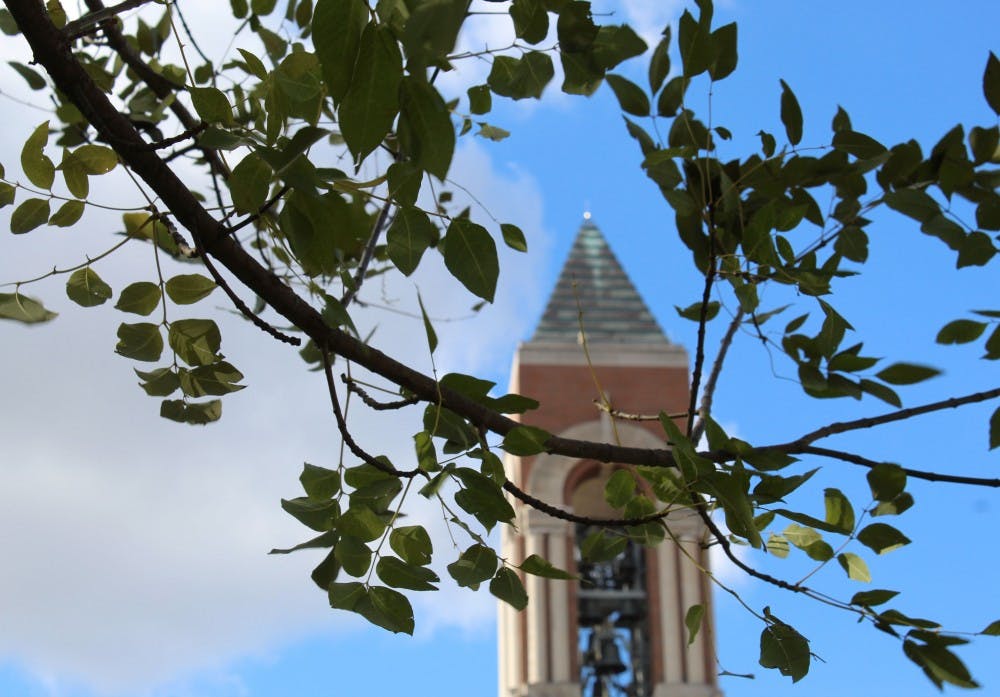Autumnal colors are on full display, with red, yellow and orange leaves contributing to the ambiance of Ball State’s campus. However, some students are puzzled that the landscape only began to change in late October.
“It’s happening a lot later in October than I would’ve expected,” said Nevaeh Dye, a student at the Indiana Academy for Science, Mathematics, and Humanities. “It’s definitely like an earlier stage of yellow.”
Dye, who frequents Christy Woods, said she only saw the leaves change color sometime last week and that it was strange to see them change this late.
Along with the green pigment, chlorophyll, leaves also contain yellow and orange carotenoids which remain hidden due to greater amounts of green coloring, a document by the Department of Agriculture’s Forest Service states.
Partly due to drop in temperatures and shorter periods of daylight, the chlorophyll breaks down, the green pigmentation disappears and the yellowish color is visible. Chemical changes may occur adding additional pigments that give rise to red and purple tints .
“Twenty years ago, peak color was probably a little earlier,” said John Taylor, land manager at Ball State’s Field Station and Environmental Education Center. “But … we’re right on time with the last several years.”
Taylor said the center has noted there is a trend for a longer growing season and warmer weather year-round. He said there is no concern with the late change in leaf colors, but rather with the cause of it — he doesn’t see how climate change could not have anything to do with it.
Purdue University’s Indiana climate change impact assessment states that trends of a warmer and wetter spring, and summer and fall becoming hotter and drier, are projected to continue. Since 1895, Indiana’s statewide annual average temperature has risen by 1.2 degrees, or about 0.1 degrees per decade, the assessment states.
It also states Indiana’s annual average temperature is expected to rise 5 to 6 degrees by mid-century and 6 to 10 degrees by the end of this century, depending on the amount of heat-trapping gases released to the atmosphere by human activities.
While adequate summer rains help promote color production in leaves during the fall, rainy and windy weather during the fall can prematurely knock down leaves thereby shortening the color display at its peak, states the website of Harvard University’s ecological research site, Harvard Forest.
Purdue University’s assessment states that Indiana summers could get 7 percent less rain and warmer temperatures could lead to water stress in forests due to higher speeds of evaporation.
“Changing leaves — that’s just an observation,” Taylor said. “It’s just one more data point in this vast compilation of data that says that our climate is changing because of human activity.”
Students like Shana Welling, a sophomore in history, appreciate the nice warm weather in October. Welling also said leaves have been changing color later than usual, citing climate change as a possible explanation.
“As for now, it’s really nice out,” Welling said. “And hopefully, it stays this way until early December, so we can get nice weather and not have to worry about the cold.”
According to Smoky Mountains’ interactive 2018 fall foliage prediction map, which shows predicted stages of changing leaf colors across the country, Delaware County is predicted to see peak fall colors this week.
“Go outside, it’s beautiful,” Taylor said. “The leaves … are coming into their peak right now; so this is the time to go out and observe.”
Contact Rohith Rao with comments at rprao@bsu.edu or on Twitter @RaoReports.





